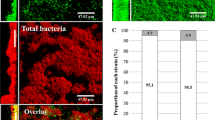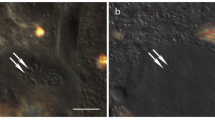Abstract
Rhodotorula spp. and Trichosporon spp. are opportunistic pathogens, and although an association between these two species in the same infection appears to be uncommon, it has been reported. This is the first study that aimed to evaluate the pathogenesis of a co-infection by R. mucilaginosa and T. asahii, using a new in vivo model, the Zophobas morio larvae. Suspensions from planktonic and biofilm-recovered cells were injected in the larvae as in monospecies as mixed (a ratio of 1:1 for both agents of a of 105 inoculum). Individual and mixed biofilms of R. mucilaginosa and T. asahii were produced for 24 and 48 h, and they were partially characterized by crystal violet and reduction of tetrazolium salt. When evaluating the impact of the planktonic suspension in vivo we verified that the fungi in monoculture were more able to kill the larvae than those from planktonic mixed suspension. On the other hand, regarding biofilm-recovered cells, there was an increase in the death of larvae infected for mixed suspensions. Moreover, the death rate was more pronounced when the larvae were infected with 48 h biofilm-recovered cells than the 24 h ones. T. asahii was the best producer of total biomass, mainly in 48 h. The metabolic activity for both yeasts organized in biofilm maintained the same pattern between 24 and 48 h. The present study proves a synergistic interaction between R. mucilaginosa and T. asahii after an experience in a mixed biofilm. Our results suggest that both species were benefited from this interaction, acquiring a greater potential for virulence after passing through the biofilm and this ability was acquired by the cells released from the biofilm.



Similar content being viewed by others
References
Jarros IC, Veiga FF, Corrêa JL, Barros ILE, Gadelha MC, Voidaleski MF, et al. Microbiological and virulence aspects of Rhodotorula mucilaginosa. EXCLI J. 2020;19:687–704.
Singh S, Capoor MR, Varshney S, Gupta DK, Verma PK, Ramesh V. Epidemiology and antifungal susceptibility of infections caused by spec- and non-yeast worldwide. Indian J Med Microbiol. 2019;37:536–41. https://doi.org/10.4103/ijmm.IJMM_19_146.
Ioannou P, Vamvoukaki R, Samonis G. Rhodotorula species infections in humans: a systematic review. Mycoses. 2019;62:90–100. https://doi.org/10.1111/myc.12856.
Colombo AL, Padovan ACB, Chaves GM. Current knowledge of Trichosporon spp and Trichosporonosis. Clin Microbiol Rev. 2011;24:682–700. https://doi.org/10.1128/CMR.00003-11.
Zhang E, Sugita T, Tsuboi R, Yamazaki T, Makimura K. The opportunistic yeast pathogen Trichosporon asahii colonizes the skin of healthy individuals: analysis of 380 healthy individuals by age and gender using a nested polymerase chain reaction assay. Microbiol Immunol. 2011;55:483–8. https://doi.org/10.1111/j.1348-0421.2011.00341.x.
Gomez-Lopez A, Mellado E, Rodriguez-Tudela JL, Cuenca-Estrella M. Susceptibility profile of 29 clinical isolates of Rhodotorula spp and literature review. J Antimicrob Chemother. 2005;55:312–6. https://doi.org/10.1093/jac/dki020.
Ge G, Li D, Mei H, Lu G, Zheng H, Liu W, et al. Different toenail onychomycosis due to Rhodotorula mucilaginosa and Candida parapsilosis in an immunocompetent young adult. Medical Mycology Case Reports. 2019. p. 69–71. http://dx.doi.org/https://doi.org/10.1016/j.mmcr.2019.04.012
Pârvu M, Moţ CA, Pârvu AE, Mircea C, Stoeber L, Roşca-Casian O, et al. Allium sativum extract chemical composition, antioxidant activity and antifungal effect against Meyerozyma guilliermondii and Rhodotorula mucilaginosa causing onychomycosis. Molecules. 2019. p. 3958. http://dx.doi.org/https://doi.org/10.3390/molecules24213958
Francisco EC, de Almeida Junior JN, de Queiroz TF, Aquino VR, Mendes AVA, de Andrade Barberino MGM, et al. Species distribution and antifungal susceptibility of 358 Trichosporon clinical isolates collected in 24 medical centres. Clin Microbiol Infect. 2019;25:909.e1-909.e5. https://doi.org/10.1016/j.cmi.2019.03.026.
Vasconcellos C, Pereira CQM, Souza MC, Pelegrini A, Freitas RS, Takahashi JP. Identification of fungi species in the onychomycosis of institutionalized elderly. An Bras Dermatol. 2013;88:377–80. https://doi.org/10.1590/abd1806-4841.20131884.
Idris NFB, Huang G, Jia Q, Yuan L, Li Y, Tu Z. Mixed infection of toe nail caused by Trichosporon asahii and Rhodotorula mucilaginosa. Mycopathologia. 2019. https://doi.org/10.1007/s11046-019-00406-y.
Solano C, Echeverz M, Lasa I. Biofilm dispersion and quorum sensing. Current Opinion in Microbiology. 2014. p. 96–104. http://dx.doi.org/https://doi.org/10.1016/j.mib.2014.02.008
Garcia LM, Costa-Orlandi CB, Bila NM, Vaso CO, Gonçalves LNC, Fusco-Almeida AM, et al. A two-way road: antagonistic interaction between dual-species biofilms formed by Candida albicans/Candida parapsilosis and Trichophyton rubrum. Front Microbiol. 2020;11:1980. https://doi.org/10.3389/fmicb.2020.01980.
Harris MR, Coote PJ. Combination of caspofungin or anidulafungin with antimicrobial peptides results in potent synergistic killing of Candida albicans and Candida glabrata in vitro. International Journal of Antimicrobial Agents. 2010. p. 347–56. http://dx.doi.org/https://doi.org/10.1016/j.ijantimicag.2009.11.021
Olson ML, Jayaraman A, Kao KC. Relative abundances of Candida albicans and Candida glabrata in coculture biofilms impact biofilm structure and formation. Appl Environ Microbiol. 2018. https://doi.org/10.1128/AEM.02769-17.
Trejo-Hernández A, Andrade-Domínguez A, Hernández M, Encarnación S. Interspecies competition triggers virulence and mutability in Candida albicans-Pseudomonas aeruginosa mixed biofilms. ISME J. 2014;8:1974–88. https://doi.org/10.1038/ismej.2014.53.
Gupta AK, Foley KA. Evidence for biofilms in onychomycosis. G Ital Dermatol Venereol. 2019;154:50–5. https://doi.org/10.23736/S0392-0488.18.06001-7.
Faergemann J, Baran R. Epidemiology, clinical presentation and diagnosis of onychomycosis. Br J Dermatol. 2003;149(Suppl 65):1–4. https://doi.org/10.1046/j.1365-2133.149.s65.4.x.
Paškevičius A, Švedienė J, Kiverytė S, Bridžiuvienė D, Vaitonis G, Jablonskienė V. Candida distribution in onychomycosis and in vitro susceptibility to antifungal agents. Acta Dermatovenerol Cro At. 2020;28:204–9.
de Souza PC, Morey AT, Castanheira GM, Bocate KP, Panagio LA, Ito FA, et al. Tenebrio molitor (Coleoptera: Tenebrionidae) as an alternative host to study fungal infections. J Microbiol Methods. 2015;118:182–6. https://doi.org/10.1016/j.mimet.2015.10.004.
Negri M, Silva S, Capoci IRG, Azeredo J, Henriques M. Candida tropicalis biofilms: biomass, metabolic activity and secreted aspartyl proteinase production. Mycopathol. 2016;181:217–24. https://doi.org/10.1007/s11046-015-9964-4.
Du M, Liu X, Xu J, Li S, Wang S, Zhu Y, et al. Antimicrobial effect of Zophobas morio hemolymph against bovine mastitis pathogens. Microorganisms. 2020. p. 1488. http://dx.doi.org/https://doi.org/10.3390/microorganisms8101488
Tokarev YS, Malysh SM, Volodartseva YV, Gerus AV, Berezin MV. Molecular identification of a densovirus in healthy and diseased Zophobas morio (Coleoptera, Tenebrionidae). Intervirol. 2019;62:222–6. https://doi.org/10.1159/000508839.
Carvalho MC, Tomazini A, Prado RA, Viviani VR. Selective inhibition of Zophobas morio (Coleoptera: Tenebrionidae) luciferase-like enzyme luminescence by diclofenac and potential suitability for light-off biosensing. Luminescence. 2021;36:367–76. https://doi.org/10.1002/bio.3952.
dos Santos JD, dos Santos JD, Piva E, Vilela SFG, Jorge AOC, Junqueira JC. Mixed biofilms formed by C albicans and non-albicans species: a study of microbial interactions. Brazilian Oral Res. 2016. https://doi.org/10.1590/1807-3107bor-2016.vol30.0023.
Uppuluri P, Chaturvedi AK, Srinivasan A, Banerjee M, Ramasubramaniam AK, Köhler JR, et al. Dispersion as an important step in the Candida albicans biofilm developmental cycle. PLoS Pathog. 2010;6: e1000828. https://doi.org/10.1371/journal.ppat.1000828.
Thet NT, Wallace L, Wibaux A, Boote N, Jenkins ATA. Development of a mixed-species biofilm model and its virulence implications in device related infections. J Biomed Mater Res B Appl Biomater. 2019;107:129–37. https://doi.org/10.1002/jbm.b.34103.
Lohse MB, Gulati M, Johnson AD, Nobile CJ. Development and regulation of single- and multi-species Candida albicans biofilms. Nat Rev Microbiol. 2018;16:19–31. https://doi.org/10.1038/nrmicro.2017.107.
Iñigo M, Del Pozo JL. Fungal biofilms: From bench to bedside. Rev Esp Quimioter. 2018;31(Suppl 1):35–8.
Demuyser L, Jabra-Rizk MA, Van Dijck P. Microbial cell surface proteins and secreted metabolites involved in multispecies biofilms. Pathog Dis. 2014;70:219–30. https://doi.org/10.1111/2049-632X.12123.
Biegańska MJ, Rzewuska M, Dąbrowska I, Malewska-Biel B, Ostrzeszewicz M, Dworecka-Kaszak B. Mixed infection of respiratory tract in a dog caused by Rhodotorula mucilaginosa and Trichosporon jirovecii: a case report. Mycopathologia. 2018. p. 637–44. http://dx.doi.org/https://doi.org/10.1007/s11046-017-0227-4
Pantanella F, Valenti P, Natalizi T, Passeri D, Berlutti F. Analytical techniques to study microbial biofilm on abiotic surfaces: pros and cons of the main techniques currently in use. Ann Ig. 2013;25:31–42. https://doi.org/10.7416/ai.2013.1904.
Acknowledgements
This study was supported by Coordenação de Aperfeiçoamento de Pessoal de Nível Superior – Brasil (CAPES)—Finance Code 001, Conselho Nacional de Desenvolvimento Científico e Tecnológico (CNPq) no. 421620/2018-8 and Fundação de Amparo à Pesquisa do Estado do Paraná (Fundação Araucária).
Author information
Authors and Affiliations
Contributions
Isabele Carrilho Jarros: Conceived of or designed study, Performed research, Analyzed data and Wrote the paper. Isabella Letícia Esteves Barros: Performed research and Analyzed data. Andressa Prado: Performed research. Jakeline Luiz Corrêa: Performed research. Amanda Milene Malacrida: Analyzed data and Wrote the paper. Melyssa Negri: Analyzed data and Wrote the paper. Terezinha Inez Estivalet Svidzinski: Conceived of or designed study, Analyzed data and Wrote the paper.
Corresponding author
Ethics declarations
Conflict of interest
The authors declare that they have no conflicts of interest.
Additional information
Publisher's Note
Springer Nature remains neutral with regard to jurisdictional claims in published maps and institutional affiliations.
Handling Editor: Damien Costa.
Rights and permissions
About this article
Cite this article
Jarros, I.C., Barros, I.L.E., Prado, A. et al. Rhodotorula sp. and Trichosporon sp. are more Virulent After a Mixed Biofilm. Mycopathologia 187, 85–93 (2022). https://doi.org/10.1007/s11046-021-00606-5
Received:
Accepted:
Published:
Issue Date:
DOI: https://doi.org/10.1007/s11046-021-00606-5




